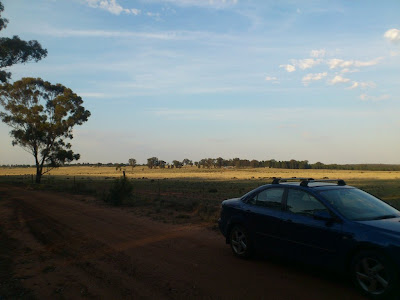High-tailing it through flooded roads in country NSW during the bad rainstorms of March 2012.
I leave the clinic, all excited, keys jangling in my hand. I'm on a mission!
Click the work car's door open, ease into the driver's seat. Place the keys into and then turn it in the ignition slot. The engine purrs into life, and I step on both the brake and clutch so that I can ease the gearstick into reverse. Next, I release the handbrake.
Tentatively, gently, my left foot releases the clutch and feels for that drop in engine RPM, while my right foot positions itself on the accelerator pedal, ready to inject that bit of 'juice' when required. Being unfamiliar with the car's biting point, I take my time and do it slow.
A 14 minute joyride later, after travel involving unsealed roads as well as a section of 100km/hr highway, I'm back at my starting point, smiling, and in possession of a blood test that I've obtained from a nearby vet clinic.
I learnt how to drive in Singapore, and I learnt in a manual car. I remember it being a long and frustrating process, and into my 8th lesson, I was still stalling the vehicle. I arrived home in tears that day and declared to my family that I would never be able to drive.
That was 9 years ago. Since then, I've moved to Australia and due to the necessity (and convenience) of driving, I haven't looked back. It is an automatic car that I regularly drive though, so the chance to drive a manual vehicle very much tickles me even now.
I don't know why exactly it is, but I love driving.
Just chilling out in the forest reserve, my car and I.
Maybe it's the feeling of speed, movement, momentum, progress, torque - whichever terms you may choose to describe it.
Maybe because it's fast travel with beautiful vistas (especially in Australia) to relax to.
Maybe because it simply represents freedom.
It probably is all of the above.
I also love walking along a road in the evening time and seeing cars travel alongside on the road - the sleek profile of the modern car hurtling along - it's evocative and sexy.
I've driven on highways with 130km/hr speed limits, on unsealed dirt roads, on uneven 4wd tracks, on beautiful winding coastal roads, on climbing mountain roads, and even on surface-flooded roads (the water not being high enough to reach the car's air intake). I've driven across Australia, on Singapore's highways, in Thailand, in New Zealand. I've hit a kangeroo, run over a fox, killed cane toads and avoided a family of emus crossing the highway.
The car and the internal combustion engine are amazing feats of engineering. I busied myself one evening last year with learning how the engine works...how all the parts come together to form this incredible machine.
Crankshafts, camshafts, cylinders, pistons, spark plugs (for petrol models), valves...The variance in the number of cylinders and the different engine configurations. How automotive engineers increase the power output of internal combustion engine.
Also, the different types of car engines - I've seen a caburetor engine thrumming along under the hood of a car. Also, I've been in a neighbour's combined electric/petrol car and been amazed at how quiet it is. And of course, I've driven and loved the 'ol trusty fuel-injected models.
Petrol vs diesel engines? Front, mid or rear engines? Front or rear or 4-wheel drive? The different configurations are endless.
As a word of warning, don't get me started on motorbikes, boats and planes...I could go on and on :)
I love offroad driving :)
*RPM: revolutions per minute




.jpg)



.jpg)